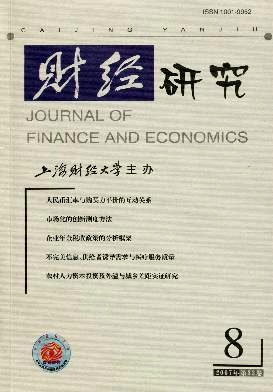中国资本形成与经济增长的动态相关性——基于协变模型的实证分析
财经研究 2007 年 第 33 卷第 08 期, 页码:133 - 144
摘要
参考文献
摘要
文章根据1952~2005年的样本数据,利用带有结构突变的单位根检验方法和协变模型判定了我国国内生产总值和资本形成总额时间序列均是带有一次均值突变的趋势平稳过程,证实了我国经济增长与资本形成之间存在着同期协变关系;并利用脉冲响应函数、方差分解以及动态相关系数研究了中国经济增长和资本形成间的动态相关性。最后,文章在此分析基础上得出了主要结论,并提出相应的政策建议。
[1]Lumsdaine R,Papell D.Multiple trend breaks and the unit-root test[J].The Review ofEconomics and Statistics,1997,(79):212~218.
[2]Li Xiaoming.The great leap forward,economic reforms and the unit root hypothesis:Testing for breaking trendfunctions in China’s GDP data[J].Journal of Comparative E-conomics,2000,(28):814~827.
[3]Li Xiaoming.China’s economic growth:What do we learn from multiple-break unit roottests?[EB/OL].http://www.cenet.org.cn/cn/ReadNews.asp?NewsID=13822,2003,第三届中国经济学年会会议论文.
[4]Ng S,Perron P.Unit root test in ARMA models with data-dependent methods for theselection of the truncation Lag[J].Journal of the American Statistical Association,1995,(90):268~281.
[5]Perron P.The great crash,the oil-price shock and the unit-root[J].Econometrica,1989,(57):1519~1554.
[6]Paul A Samuelson,William D Nordhaus.Economics[M].Beijing:China Machine Press,1998:540.
[7]Zivot E,Andrews D.Further evidence onthe great crash,the oil-price shock and the unit-root hypothesis[J].Journal of Business and Economic Statistics,1992,(10):251~270.
[8]类淑志,张耿庆.资本形成与中国区域经济增长[J].生产力研究,2003,(5):140~144.
[9]周建,汪伟.资本形成、投资效率与经济增长之间的动态相关性———来自中国1978~2004年数据的实证研究[J].财经研究,2006,(2):78~89.
[10]栾惠德.带有结构突变的单位根检验———文献综述[J].数量经济技术经济研究,2007,(3):152~161.
[11]栾惠德,张晓峒.中国人口时间序列的单位根检验:基于结构突变理论[J].经济学报,2006,(2):110~122.
[12]张军.资本形成、工业化与经济增长:中国的转轨特征[J].经济研究,2002,(6):3~13.
[13]李治国,唐国兴.资本形成路径与资本存量调整模型———基于中国转型时期的分析[J].经济研究,2003,(2):34~42.
①中国国家统计局:《中国统计年鉴》(2006),中国统计出版社,2006年版。
②中国国家统计局国民经济综合统计司:《新中国55年统计汇编1949-2004》,中国统计出版社,2005年版。
③国内学者栾惠德(2007)的《带有结构突变的单位根检验———文献综述》一文对此有较详细的论述。
④t-sing方法在选择滞后长度时具有检验水平稳定和检验功效高的特点,优于传统的信息准则,如AIC和BIC等(参见Ng和Perron,1995;Perron,1997)。
⑤临界值参见国内学者栾惠德和张晓峒(2006)的《中国人口时间序列的单位根检验:基于结构突变理论》一文,发表于《经济学报》2006年第3期,第117页。
[2]Li Xiaoming.The great leap forward,economic reforms and the unit root hypothesis:Testing for breaking trendfunctions in China’s GDP data[J].Journal of Comparative E-conomics,2000,(28):814~827.
[3]Li Xiaoming.China’s economic growth:What do we learn from multiple-break unit roottests?[EB/OL].http://www.cenet.org.cn/cn/ReadNews.asp?NewsID=13822,2003,第三届中国经济学年会会议论文.
[4]Ng S,Perron P.Unit root test in ARMA models with data-dependent methods for theselection of the truncation Lag[J].Journal of the American Statistical Association,1995,(90):268~281.
[5]Perron P.The great crash,the oil-price shock and the unit-root[J].Econometrica,1989,(57):1519~1554.
[6]Paul A Samuelson,William D Nordhaus.Economics[M].Beijing:China Machine Press,1998:540.
[7]Zivot E,Andrews D.Further evidence onthe great crash,the oil-price shock and the unit-root hypothesis[J].Journal of Business and Economic Statistics,1992,(10):251~270.
[8]类淑志,张耿庆.资本形成与中国区域经济增长[J].生产力研究,2003,(5):140~144.
[9]周建,汪伟.资本形成、投资效率与经济增长之间的动态相关性———来自中国1978~2004年数据的实证研究[J].财经研究,2006,(2):78~89.
[10]栾惠德.带有结构突变的单位根检验———文献综述[J].数量经济技术经济研究,2007,(3):152~161.
[11]栾惠德,张晓峒.中国人口时间序列的单位根检验:基于结构突变理论[J].经济学报,2006,(2):110~122.
[12]张军.资本形成、工业化与经济增长:中国的转轨特征[J].经济研究,2002,(6):3~13.
[13]李治国,唐国兴.资本形成路径与资本存量调整模型———基于中国转型时期的分析[J].经济研究,2003,(2):34~42.
①中国国家统计局:《中国统计年鉴》(2006),中国统计出版社,2006年版。
②中国国家统计局国民经济综合统计司:《新中国55年统计汇编1949-2004》,中国统计出版社,2005年版。
③国内学者栾惠德(2007)的《带有结构突变的单位根检验———文献综述》一文对此有较详细的论述。
④t-sing方法在选择滞后长度时具有检验水平稳定和检验功效高的特点,优于传统的信息准则,如AIC和BIC等(参见Ng和Perron,1995;Perron,1997)。
⑤临界值参见国内学者栾惠德和张晓峒(2006)的《中国人口时间序列的单位根检验:基于结构突变理论》一文,发表于《经济学报》2006年第3期,第117页。
引用本文
赵娜, 张少辉. 中国资本形成与经济增长的动态相关性——基于协变模型的实证分析[J]. 财经研究, 2007, 33(8): 133–144.
导出参考文献,格式为:





 6094
6094  732
732

